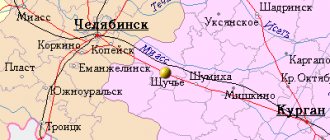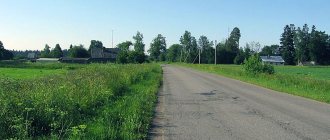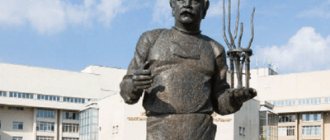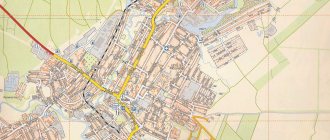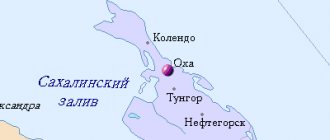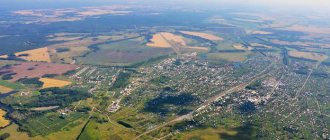Makushino
, a city in Russia, the administrative center of the Makushinsky district of the Kurgan region, within the Kurgan diocese. Located 131 km southeast of Kurgan, railway. station on the line Kurgan - Petropavlovsk. Population - 7984 people (2014) [1]
- On the map: Yandex.Map, Google map
The first mention of the settlement of Makushino dates back to 1797, when the peasant Fyodor Tikhonovich Makhnev built the first hut on the shore of the lake of the same name. Initially, the village of Makushina was part of the Obutkovskaya volost of the Kurgan district. In 1895, the Siberian Railway was built near the village, on which the Makushino station appeared, located half a mile away. In 1897, the village of Makushenskoye became the center of the volost of the same name.
Since 1897, there was a one-class school of the Ministry of Internal Affairs [2], and since 1898, a parochial school at the railway station.
At the beginning of the century, three fairs were held in the village (January 18-24; June 20-26; November 15-21) and weekly markets. According to the reference book “Russia. A complete geographical description of our Fatherland...", "in the village. Makushino is concentrated in grain trade, trade turnover reaches 650 thousand rubles. of which 600 tr. fall to the share of the grain trade" [3].
By the beginning of the 1910s, Makushinsky had a postal and telegraph office, a pharmacy, a library, a bakery store, a tavern, an inn, a wine shop, 77 trading shops, more than 20 windmills, the Makushinsky butter factory (since 1903), six forges, a zemstvo station. A savings bank operated under the volost government.
On February 29, 1924, the Makushinsky district was formed and was part of the Kurgan district of the Ural region. In 1926, the village housed a village council, a first-level school, a paramedic station, a veterinary station, a telephone, a telegraph, a post office, an agronomic center, and a cooperative. Since 1929, Makushino has been a peasant-worker village. Since 1934 - part of the Chelyabinsk region, since February 6, 1943 - Kurgan region. By a decree of the Presidium of the Supreme Soviet of the RSFSR dated April 17, 1944, Makushino was classified as a workers' village. From January 1963 to March 1964, the Makushinsky district was part of the Petukhovsky district.
On February 23, 1963, Makushino was given city status.
At the beginning of the 21st century, the city had a local history museum, mechanical repair and butter factories, a variety testing station, and an elevator [4].
Statistics
- 1812 - 50 households, 386 people [5]
- 1868 - 204 households, 956 people [6]
- 1893 - 216 peasant households, 969 people [7]
- OK. 1910 - village: more than 340 villages. households, 1294 people; station: 275 people; station village: 35 villages households, 200 people [8]
- 1926 - village: 843 households, 3425 people (Russians - 3205 people, Tatars - 181 people); station: 68 households, 280 people; station village: 159 households, 608 people [9]
- 1959 - 15 thousand people [5]
- 1989 - 10,766 people [10]
- 2002 - 9942 people [10]
- 2010 - 8338 people [10]
- 2012- 8229 people [11]
Makushino
From the foundation to the beginning of the 20th century
In 1797, the peasant Fyodor Tikhonovich Makhnev with his sons Alexei, Nikifor, Fyodor and grandson Yakov, aged eight, built a hut in the “newly established village”. According to documents of the Tobolsk Treasury Chamber for 1812, there were already 50 households in Makushino, in which 193 male residents and the same number of female residents lived.
In the List of populated places of the Tobolsk province for 1871, the state-owned village of Makushina appears in the Kurgan district near Lake Makushin. The village had 204 households and 956 residents of both sexes - 476 males and 480 females. In 1895, the first train passed through the Makushino station of the new railway.
In 1897, a small wooden church of the Entry of the Blessed Virgin Mary into the Temple was built in the village, and from then on Makushino began to be called a village. Of the 1,093 village residents, 54 people were exiles. There were only 28 literate people. The main occupation of the population was growing bread, 4 people were engaged in shoemaking, 4 in carpentry.
In 1897, the Makushinsky School of the Ministry of Internal Affairs was opened, in which, according to 1916 data, there were 125 students (63 boys, 62 girls). In 1903, a butter factory was founded. Four eastbound trains passed through the station daily. Near the station there were 40 villages with a population of about 30 thousand souls.
According to information from 1904, on the zemstvo tract at Lake Makushinsky there were: a church, a chapel, a zemstvo station, a volost administration with a savings bank and postal operations, a school, a library, a grain store, a state-owned wine shop, a pharmacy, 12 trading stores, a railway station, weekly markets, 2 fairs.
The List of populated places of the Tobolsk province for 1912 shows: the village of Makushinskoye at Lake Makushino, the Makushino station of the Siberian Railway at Lake Makushino and the village of Makushinsky at the railway station, all 140 versts from the district town of Kurgan. The villages were part of the Makushinsky volost. In the village of Makushinskoye there were 1,294 inhabitants (650 men and 644 women), there were: a church and a chapel, a library, a school, a bread store, a tavern, an inn, a wine shop, 77 trading stores, 25 windmills, an oil mill, 2 factories ( plant), 6 forges, postal and zemstvo stations, 3 fairs (market). Makushino station had 275 residents (125 men and 150 women), and there was a school here. In the village of Makushinsky there were 200 inhabitants (96 men and 104 women), there were 3 trading shops.
Makushino after the revolution
On February 29, 1924, the Makushinsky district was formed, the center of which became Makushino. In 1926, the area was divided into 3 police stations. On April 21, 1927, a company was launched in the area to combat moonshine, which created great obstacles in carrying out agricultural work.
In the summer of 1928, the Makushinsky state farm was organized, which was allocated 41,832 hectares of land for construction. In 1929, the construction of the Makushinsky repair plant began, the village became a peasant-worker village.
Until 1930, mail delivery in the region was carried out 3 times a week. Since 1930, mail began to be delivered daily, and in that year the circulation of the district newspaper reached almost 1,295 copies. There were 2 stationary postal enterprises in the area; postal services covered 47% of settlements. 8 village councils and 2 collective farms were provided with telephones, and more than 120 telephone points operated. In 1931, a branch of the State Bank was organized on the basis of the credit partnership; Nikolai Trofimovich Kurlov worked as its manager.
In 1933, Makushinskaya MTS was formed (the first director was Alexey Spiridonovich Ivanov). The MTS farm was located on the site where there once was an old agricultural products store - on Red Square Street (near the outpatient clinic).
In 1934, Makushino became part of the newly formed Chelyabinsk region and was part of it until the formation of the Kurgan region in 1943.
In 1938, the collective farm “Rabotnik” operated in Makushin, located on the territory of the current veterinary hospital, its chairman was Ekaterina Izotova, and the secretary of the party cell was Mikhail Bykov. On the site of Bazarnaya Square there were collective farm fields.
According to information from 1939, the population of Makushin was 8,700 people, the population of the district was 32,900 people. According to the plan of the district executive committee in 1939–1942. it was planned to build a House of Culture, an editorial building, a stadium, and a pioneer camp.
A few days before the war, on June 15, 1941, the first regional competitions of trade union-Komsomol cross-country participants were held in the village of Makushino, in which 54 athletes took part. The winners at a distance of 1,000 meters were graduates of the Makushinskaya secondary school, Komsomol members Balakin and Kuvaev with results of 3 minutes and 8 seconds. During the war, in 1942, orphanages were located in the Makushinsky district, the number of pupils in which was 730 people.
April 17, 1944 By decree of the Presidium of the Supreme Soviet of the RSFSR, Makushino was classified as a workers' settlement.
In 1946, the Makushinskaya hatchery station was founded, which provided daily young animals to the farms of the region, one state farm in the Petukhovsky district and individual farms. In 1966, 20 years after its founding, 840 thousand chickens were bred at the station.
In 1948, Makushinskaya MTS completed the construction of a new power plant, which made it possible to ensure uninterrupted operation of repair shops, machine tools and MTS electric motors. In addition, electricity came to cultural institutions in the village of Setovnoye, to the apartments of workers and employees. In 1949, the workers of the railway junction fulfilled the annual plan for loading and unloading cars ahead of schedule, and the downtime of cars was reduced by 3% compared to the plan.
According to 1950 data, 3 MTS, 52 collective farms and 5 state farms operated in the region. 3,083 households were united into collective farms. In May 1951, the Makushinsky butter plant was commissioned and put into operation. In 1954, a repair plant was created on the basis of the workshops of the Makushinsky state farm. In November 1956, the inter-district “Raiposbyt” was organized in Makushin.
In 1959, the population of the village of Makushino was 13,731 people, the district - 33,900 people.
In 1960, a consumer services plant was opened in the village. In the spring of 1961, a children's music school was opened. In 1962, the bakery was put into operation. From 1963 to 1964 The territory of the Makushinsky district was part of the Petukhovsky district; in March 1964, the district was restored.
In city status
By decree of the Presidium of the Supreme Soviet of the RSFSR dated February 23, 1963, the workers' village of Makushino was given the status of a city. A vocational school was opened in 1963. In 1964, the Makushin inter-collective farm construction organization was organized; the mobile mechanized column PMK-37 carried out construction work on state farms. In 1966, gasification began in the city and region. In the same year, the Makushinsky Medical School opened.
In 1967, the population of the city of Makushino reached 15 thousand people. In 1968, a monument to Komsomol heroes was erected in the city. In 1969, the first graduate of the medical school took place - 96 graduates, nurses, set out on an independent path in life. The director of the school at that time was Elena Konstantinovna Rechkina. By 1970, the population of Makushin had decreased and amounted to 12,900 people. In 1974, the first meeting of labor veterans was held in the city.
In 1980, seven railway workers from the Makushino station were awarded the title “Honorary Railway Worker”. In 1982, the Makushino station and the Makushinsky state farm were included within the city limits. In 1988, the new railway station welcomed its first passengers.
In 1991, it was 25 years since the opening of the Makushinsky Medical School; during these years, 2,290 specialists became its graduates, of which 142 graduated with honors.
In 1992, the privatization of housing began. During the year, 349 apartments were privatized in the city. As of January 1, 1993, more than 200 peasant farms were registered in the region.
In 1997, the city of Makushino celebrated its 200th anniversary.
Links[edit]
Notes[edit]
- ^ abcdefgh Law No. 316
- ^ a b Federal State Statistics Service (2011). All-Russian Population Census 2010. Volume 1 [All-Russian Population Census 2010, vol. 1]. All-Russian Population Census 2010 [All-Russian Population Census 2010] (in Russian). Federal State Statistics Service.
- "26. The size of the permanent population of the Russian Federation by municipalities as of January 1, 2022". Federal State Statistics Service. Retrieved January 23, 2022.
- ^ abcde Law No. 419
- "On the Calculation of Time". Official Internet portal of legal information
. June 3, 2011. Retrieved January 19, 2022. - Post office. Information and computing center of OASU RPO. ( Post office
).
Search for postal service objects ( postal Search for objects
) (in Russian) - ↑
Federal State Statistics Service of Russia (May 21, 2004). The population of the Russian Federation, cities of the Russian Federation as part of federal districts, urban settlements, settlements, settlements, settlements is 3 thousand or more people. [Population of Russia, its federal districts , subjects of the Federation, districts, urban settlements, rural settlements - administrative centers and rural settlements with a population of more than 3000 people] (XLS). All-Russian Population Census of 2002 [All-Russian Population Census of 2002] (in Russian). - All-Union Population Census of 1989 Population of Union and Autonomous Republics, Autonomous Regions and Districts, Territories, Regions, Urban Settlements and Village District Centers [All-Union Population Census of 1989: Current Population of Union and Autonomous Republics, Autonomous Regions and Districts, Territories, Regions , districts, urban settlements and villages performing the functions of district administrative centers]. All-Union Population Census of 1989 [All-Union Population Census of 1989] (in Russian). Institute of Demography of the National Research University: Higher School of Economics [Institute of Demography of the National Research University: Higher School of Economics]. 1989 - via Demoscope Weekly
.
